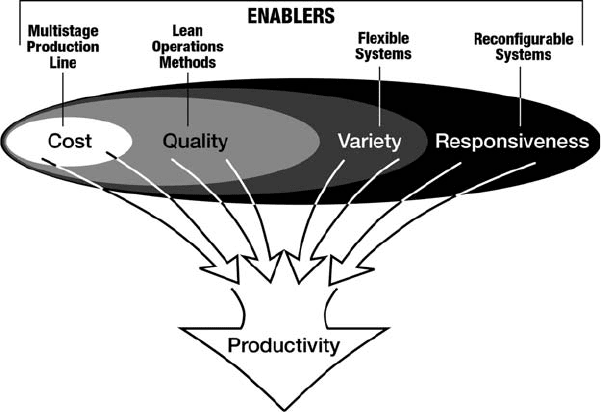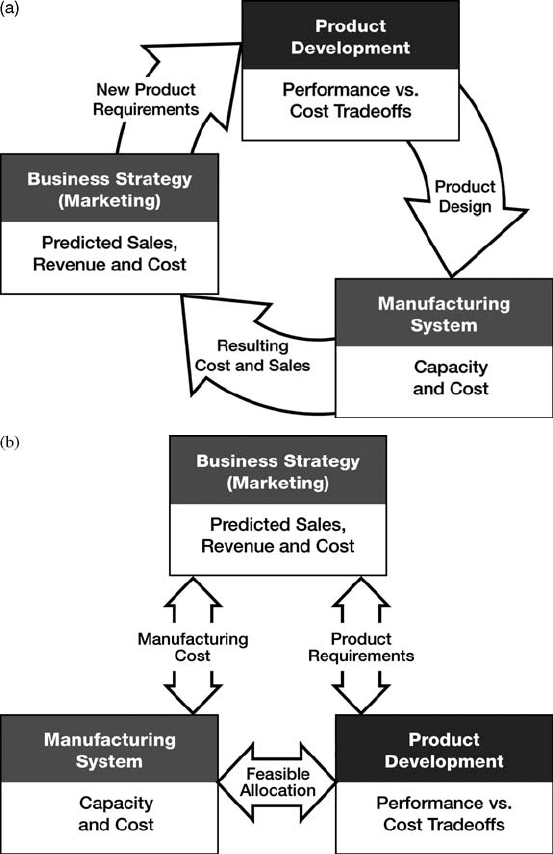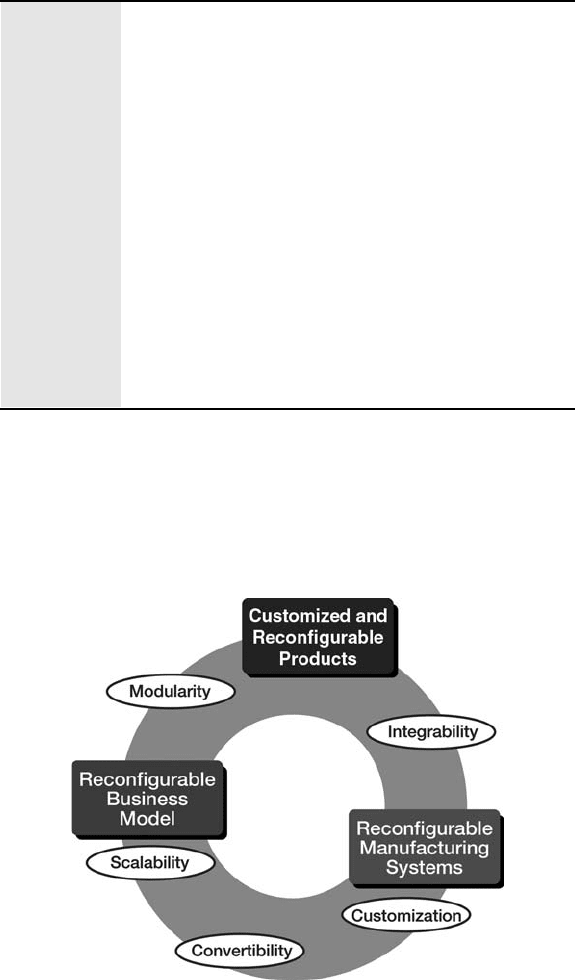Koren Y. The Global Manufacturing Revolution: Product-Process-Business Integration and Reconfigurable Systems
Подождите немного. Документ загружается.

D—Design of products for multiple regional markets and personalization
E—Empowerment of the company’s workforce with the aid of information
technology
We will elaborate below on these five core elements. This acronym also provides a
slogan that may be used to identify the goals of a global company:
Take PRIDE in your business!
14.1 P—PRODUCTIVITY
The goal of a manufacturing enterprise is to transform resources into finished products
and put them up for sale. To be profitable, this transformation must be done
at the highest productivity possible. Higher-level productivity suggests greater
efficiency—producing more with the same or fewer resources (people, machinery,
money, etc.). Increases in productivity result from better tools, improved technology,
and motivated workers.
The tight link between productivity and long-term national economic
growth makes productivity a key factor for sustaining expansion in the global
economy. A 2001 editor ial in the Economist about the state of the American economy
said:
*
“Long-term prospects in America and the rest of the world are driven by productivity.
Over the next decade or two, productivity might grow more than twice as fast as it did in
the 25 years to the mid-1990s. If new technologies really could boost growth in
productivity so much, they would go far to justify the strength of Wall Street as a
whole. This kind of productivity—with capital and labour held constant—is the true key
to a long-term quickening of economic growth.”
The key to advancing productivity gains is developing and implementing new
manufacturing technol ogies and optimizing system operations. The multi-stage
production line of the mass production system, although invented almost 100
years ago, is a shining example of a technology that enhanced productivity.
Delivering high-quality products with the aid of Lean operations methods is
another way to improve productivity because it reduces scrape and warranty costs.
Introducing computers into industrial operations and systems in the early 1990s
boosted productivity. Enhanced productivity is always achieved by reducing costs,
delivering high-quality products, producing high product variety at no additional
costs, and high speed of responsiveness to changing market conditions
(Figure 14.1).
*
The Economist, January 6, 2001, p. 72.
P—PRODUCTIVITY 361

For manufacturing companies to flourish at the dawn of the twenty-first century,
new manufacturing system technologies that enhance productivity must be invented
and implemented. Examples include:
.
Designing the production system for reconfigurability increases the system
longevity in this era of shorter product life cycles, and thereby enhanc es its
average production rate during its entire lifetime. It also shortens the time needed
for changing product models or adjusting the output volume to meet market
demands.
.
Implementing dynamic scheduling adjusts production operations to match
changing market demand.
.
Shortening ramp-up time after reconfiguration can bring the product up to its
designed capacity quickly.
.
Launching network-based approaches to factory control increases productivity
and assists in efficient maintenance.
.
Embedding in-process part inspection machines increases productivity and yield
(the percentage of resulting products within quality specifications).
Productivity gains can also be achieved by reducing the life-cycle costs of
manufacturing systems, which can be done by reducing equipment and tooling costs,
operator training costs, maintenance, etc.
To summarize, increased productivity can be gained not only by cutting expenses
but also by higher utiliza tion of manufacturing systems. Higher utilization is achieved
Figure 14.1 Productivity is improved by increasing responsiveness, cutting down costs,
and producing a greater variety of high-quality products at low costs.
362
THE TWENTY-FIRST CENTURY GLOBAL MANUFACTURING ENTERPRISE

by using new technologies to more efficiently launch, operate, and reconfigure the
manufacturing system to quickly adapt to new market conditions.
14.2 R—RESPONSIVENESS AND RECONFIGURATION
Responsiveness in industry means the speed at which a company reacts to changing
society needs and unanticipated market events as well as the speed at which business
decisions are made and executed. Speed is an imperative of the global enterprise.
Speed in developing new products, speed in reconfiguring the manufacturing system
to produce new products, and speed in taking advantage of new market opportunities.
Toyota President Fujio Cho referred to the importance of the firm’s speedy reaction to
changing markets as “the criticality of speed”.
*
In the fierce competition of the
twenty-first century it is the speed of responsiveness that will differentiate the thriving
company from the unsuccessful one.
Responsive manufacturing enterprises deliver the desired PRODUCT, in
the correct QUANTITY, at the correct TIME, at the right PLACE
The rapid reconfiguration of manufacturing systems is critical for responsiveness
to market changes. In the past, product life cycles were long and the manufacturing
system was built to produce only one product. In the twenty-first century, a single
product’s lifetime can be so short that it makes the cost of developing a one-product
manufacturing system impractical. For example, in the semi-conductor industry the
cost of a new wafer fabrication facility may reach $3 billion. Therefore, the design and
production of new products must be constrained as much as possible to use existing
manufacturing systems with short reconfiguration periods. In the future, these
systems will be reconfigured in the normal course of business for the addition of
new products, as depicted in Figure 14.2.
A well-designed reconfigurable manufacturing system will go through many
cycles of change in its lifetime, producing a whole product family that may last for
a relatively long period in one form or another (maybe 15 years or more). It starts by
producing Product A. After a couple of years, Product B is introduced and the system
is reconfigured (and rapidly ramped-up) to produce both A and B. After a few more
years, Product A is phased out and the system is reconfigured and ramped up to
produce Products B and C, and so on.
A 1998 study done by the National Academies of Engineering identified six Grand
Challenges facing manufacturing companies and came up with a ranked list of 10
Priority Research Areas needed to meet these challenges by the year 2020.
The highest-ranked Priority Research Area was identified as “Reconfigurable
*
Business Week, November 17, 2003, p. 116.
R—RESPONSIVENESS AND RECONFIGURATION 363

Figure 14.2 The next-generation manufacturing system will produce several products
during its lifetime.
Manufacturing Systems,” defined as “adaptable, integrated equipment, processes,
and systems that can be readily reconfigured for a wide range of customer require-
ments is a priority technology.”
1
The NAE report went on to emphasize the value of forming “Reconfigurable
Enterprises” defined as “the ability of an organization to form complex alliances
with other organizations very rapidly. The challenge is to reconfigure manufacturing
enterprises rapidly in response to changing needs and opportunities. Reconfigura-
tion could involve multiple organizations, a single organization, or the production/
process floor of a single organization. The driving factors for reconfigurable
enterprises are rapidly changing customer needs; rapid changing market opportu-
nities; and development i n process , p roduct, and electronic co mmunications
technology.”
Rapid responsiveness is crucial to the succ ess of the global manufactur ing
enterprise in these rapidly changing global market conditions. The product design
process must be quick and integrated with the manufacturing system t hat wil l
produce i t , as well as t he business s tr ategy that coordinates the supply of products
at the right quant ities to the right customers. Possessing a flexible system is
necessar y, but insufficient to compete globally, where th e speed of responsiveness
to new market conditions creates an opportunity for competitive advantage.
Possessing reconfigurable manufacturing systems enables companies to increase
their responsiveness because these systems can quickly adjust their production
capacity (i.e., volume per product) to match market demand and can be rapidly
tooled to produce new products. The reconfigurable manufacturing systems,
therefore, provide...
...exactly the capacity and functionality needed, exactly when needed
14.3 I—INTEGRATION OF PRODUCT, PROCESS, AND BUSINESS
A critical factor in sustaining company growth and rapidly responding
to market opportunities is the integration o f the three basic functions of the
364 THE TWENTY-FIRST CENTURY GLOBAL MANUFACTURING ENTERPRISE
manufacturing enterprise:
Design products by product development teams
Make products on manufacturing systems
Sell products by utilizing business strategies.
Traditionally, the marketing, product design, and manufacturing units work
successively on the development of new products (Figure 14.3a). Typically, the
marketing group in the business unit conducts market research and provides the
requirements and specifications for a new product to the design team, together with
their predicted sale volume and a target price. Product design then optimizes for
performance versus cost tradeoffs, where material cost is given, and with some
considerations of design for manufacturing (DFM). The product is then manufac-
tured, and the business unit tries to sell it.
In this traditional approach, profit is calculated by marketing as a function
of cost and demand, where demand depends on the price and features of the
product. The concern with this approach is that, to maximize profit, marketing
might set a list of desirable product features that are too complex and
therefore unprofitable to manufacture. It has been common practice for
marketing to be disconnected from manufacturing and set target prices without
consideration of manufacturing system characteristics. This approach must be
changed.
A more effective, integrated approach is depicted in Figure 14.3b. Here, inputs
and outputs from each unit are linked to the other two units. With this approach,
capacity allocation and ma nufac turing costs are coordinated w ith marketing
targets during product conceptualization. Furthermore, in order to reduce pro-
duction lead time and decre ase costs, every new product must be produced as much
as possible o n available machines on an existing manufacturing system that can be
reconfigured for the new product. (This is in contrast to t he conventional approach
that assumes they will be building a new manufacturing system from scratch for
the production of each new product.) Although the new approach imposes s ome
additional constraints on the product development tea m, this is the only way to
reduce lead time, decrease cost, and ultimately win the global contest for the
customer’s pocket.
Also, with this new approac h, cooperative efforts between marketing, design, and
manufacturing take place during product development instead of much later in the
process. The design team analyzes the product features and determines which
specifications are unrealistic and must be modified. This is feedback to the business
unit, which then must change the product price according to the new specifications.
The new price and modified product features may a lso change the projected demand
and production volume targets, which, in turn, will impact t he configuration of the
manufacturing s ystem.
This approach recognizes the links among the three main enterprise units in the
new product development scenario. The details of the design, cost, and
I—INTEGRATION OF PRODUCT, PROCESS, AND BUSINESS 365

capacity allocation, which are still driven by the profit objective, are
handled simultaneously instead of sequentially by design, manufacturing, and
business.
To achieve market responsiveness all three elements—the product, the
manufacturing system, and the business model—must possess a set of the same five
Figure 14.3 (a) A traditional sequential product development process. (b) An integrated,
concurrent manufacturing enterprise.
366
THE TWENTY-FIRST CENTURY GLOBAL MANUFACTURING ENTERPRISE

core characteristics that are defined below.
Scalability The ability to easily scale up or down an existing product size,
or an existing production output capacity, or the number of
partners in a strategic alliance
Convertibility The ability to easily transform the functionality of existing
products, systems, machines, or business units to suit new
requirements
Customization The ability to design variant products within a product family,
or the ability to adapt the customized flexibility of pro-
duction systems and machines to meet new market re-
quirements; in business—the ability to form a strategic
alliance that is customized to a new business opportunity
Modularity The compartmentalization of operational functions into units
that can be manipulated between alternate product, pro-
duction, or business schemes to achieve the most optimal
arrangement to fit a given set of needs
Integrability The ability to integrate product/production/business phases
and modules rapidly and precisely by a set of mechanical
and/or informational interfaces
Note that the sixth characteristic, Diagnosability, is applicable to complex
customized products (e.g., automobiles) and manufacturing systems, but it is not
applied at the ente rprise-level business model.
Figure 14.4 depicts graphically the integration (the connection) of the enterprise unit—
product, manufacturing system, business—and their common core characteristics. The
concept conv e yed in this figure indicates the specific way to link them in an integrated
Figure 14.4 The set of core characteristics needed to form a reconfigurable enterprise is
common to the product, the system, and the business models.
I—INTEGRATION OF PRODUCT, PROCESS, AND BUSINESS 367
product–process–business approach that utilizes reconfigurable business models, com-
bined with the design of regional customized, or reconfigurable products, produced on
reconfigurable manufacturing systems, to enhance the speed of enterprise responsiv eness.
The integration and links between product design, the manufacturing system, and
business requires a set of methodologies including concurrent product design for
manufacturing (DFM), designing the product for service, building supply chains, and
methods for handling the logistics of product variety. Creating tools that enable a
business to sustain long-term relationships with their customers is an important goal of
the manufacturing enterprise. The customer is the focus of all three units of the
manufacturing enterprise: product design for the customer, making high-quality, cost-
effective products for the customer, benefiting the customer by providing good service,
and developing enduring relationships with the customers to build a brand name.
14.4 D—DESIGN FOR THE GLOBAL MANUFAC TURING PARADIGM
With the ever-increasing competition of globalization, customers have more power and
their preferences can be satisfied to a higher degree, at an affordable price, than ever
before.Intheglobalmanufacturingparadigm,this productdesigntrendhas twoaspects:
1. Products designed for multiple world markets, matching the customer’s
purchasing power, needs, and culture in specific regions.
2. Personalized products tailored specifically to individual customer’s needs
and preferences, targeting a market-of-one.
When designing products for various global markets, the goal is to design a line of
products with similar basic functional ity (e.g., washers and dryers), but different
features to fit different price ranges and living conditions. Global products are
customized to make them fit the customer’s purchasing ability, to the customers’
culture, needs, and preferences, as well as to the country’s regulatory environment
The products should be designed so they can be manufactured in factories that are
globally distributed, which makes product design more challenging than ever before.
It has to match the available local manufacturing capacity as well as the purchasing
power, culture, and regulations of the population in the target country. Developing
products whose prices fit the purchasing power of customers in target countries and
regions opens new markets and expands regional sales.
The personalized product category is aimed at more wealthy customers who desire
a higher degree of attention to their personal needs than just purchasing sets of
customized options offered by manufacturers. This trend toward personalized
production can be done economically only if produc ts become more modular, and
are designed with open architecture for mechanical, electric, and information
interfaces. This approach enables a two-stage design of pers onalized products:
1. Design of the product architecture and range of modules by the manufacturer.
Then the product is contracted and sold.
368 THE TWENTY-FIRST CENTURY GLOBAL MANUFACTURING ENTERPRISE

2. Design of the personalized product—selecting and arranging modules by the
customer. Then the final product is assembled for the individual customer.
With this two-stage approach the sale precedes bo th the final design and the
manufacturing and final assembly, which brings about a substantial economic
advantage to the man ufacturing enterprise. When this approach is adopted by the
auto industry and mechanical-electrical open-architecture standards are established,
dozens of small new companies will start to produce special modules (such as dog
baskets and storage cabinets), which will evolve to several new industries. Instead of
just trading used cars, people will start to trade used modules as their needs change and
they want to update and remodel their existing cars. Because this personalized
production business model is beneficiary to both the manufacturers (that are being
paid before the product is built) and to the customers (who are getting exactly the
product that they need), and because it will generate new industries that produce
innovative modules, it could be a giant booster to the local economy.
A second type of personalized design products contains non-modular products that
are made to fit some dimensional measures of the customer’s body. Examples include
shoes (as described in Chapter 3), the internal foam of bicycle helmets,
*
and the grips
of tennis rackets that can be made to fit the player’s hand.
Personalized production entails a new business model, requiring closer interaction
than ever before among the product development, the manufacturing systems, and the
business unit, with a focus on the customer who is at the center.
14.5 E—EMPOWERMENT OF THE WORKFORCE
Perhaps the most important asset that makes a manufacturing company great is
motivated people. The instructions and expectations from the employees, however,
must be reasonable. The king, in the book “The Little Prince” by Antoine De Saint-
Exupery, explains this point very well:
*
Professor Jack S. Hu initiated the personalized bicycle helmet project.
E—EMPOWERMENT OF THE WORKFORCE 369
The old industrial culture that was characterized by “I’m the boss. Do what I say
and don’t use your brain!” is over. Leading manufacturing companies are striving to
develop a culture in which every employee cares about the company and feels some
sense of ownership.
2
To accomplish this goal, however, it is not enough to motivate employees to think
about the consequence s of their actions. Employee s must have information that
enables them to make intelligent decisions and help them to be responsible for the
outcome of their actions. For example, by having the right information about the
operating status of the manufacturing system and the daily production targets,
employees on the production line can help find new opportunities to enhance
productivity and improve product quality.
Employees at all levels must have reasonable instructions and be empowered with
the authority to make critical judgments. But mak ing critical decisions requires skills,
information, and knowledge. Information technology, when planned correctly, dis-
tributes knowledge where it is needed and when it is needed. Knowledge combined
with the loyalty of employees and their dedication to the success of the company can
foster a strong competitive advantage.
At the higher levels of an organization, when giving timely information, managers
can think about modifying products and ways to better satisfying customer’s needs.
This will enhance customer satisfaction and increase the company’s competitive
edge.
Striving toward information-based empowerment encourages an entrepreneur-
ial spirit in the company. This spirit, combined with a greater sense of ownership,
speeds up the company’s responsiveness to unpredictable situations, increases
productivity, and creates a momentum of rapid innovations in the company’s product
and process.
14.6 THE DILEMMA OF GLOBALIZATION
We elaborated on the five core elements of PRIDE. Implementing PRIDE on a global
scale will sustain enterprise grow th. But there are sometimes political conditions and
global economic situations that occur because of globalization and may still put the
future of a manufacturing enterprise at risk. These situati ons are sometimes beyond the
control of the enter prise. We offer below some discussion on these issues as well as on
the dilemmas surrounding globalization.
Like it or not, globalization is here to stay. Is globalization a good trend? The
answer depends on who is being asked. If you are an employee that was laid off
because his job was transferred overseas to a low-wage produc er, you may strongly
oppose globalization. If you are an entrepreneur who formed a successful start-up
with global sales, you may praise globalization—it offers you a higher degree of
freedom than an individual has ever had before. If you are Bill Gates (don’t worry,
you’re not), and in 1998 you opened a research center in Beijing where you employ the
brightest computer scientists in China (just 1 position for 100 applications) and pay
them 20% of the correspo nding U.S. salaries, you embrace globalization. On the other
370 THE TWENTY-FIRST CENTURY GLOBAL MANUFACTURING ENTERPRISE
